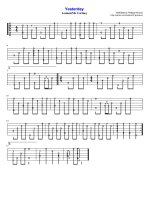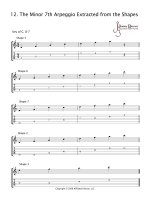06 cache friendly code 12 19 tủ tài liệu bách khoa
Bạn đang xem bản rút gọn của tài liệu. Xem và tải ngay bản đầy đủ của tài liệu tại đây (270.97 KB, 11 trang )
University
of
Washington
Sec3on
7:
Memory
and
Caches
¢
¢
¢
¢
¢
Cache
basics
Principle
of
locality
Memory
hierarchies
Cache
organiza3on
Program
op3miza3ons
that
consider
caches
Caches
and
Program
Op3miza3ons
University
of
Washington
Op3miza3ons
for
the
Memory
Hierarchy
¢
Write
code
that
has
locality
§ Spa$al:
access
data
con$guously
§ Temporal:
make
sure
access
to
the
same
data
is
not
too
far
apart
in
$me
¢
How
to
achieve?
§ Proper
choice
of
algorithm
§ Loop
transforma$ons
Caches
and
Program
Op3miza3ons
University
of
Washington
Example:
Matrix
Mul3plica3on
c = (double *) calloc(sizeof(double), n*n);
/* Multiply n x n matrices a and b */
void mmm(double *a, double *b, double *c, int n) {
int i, j, k;
for (i = 0; i < n; i++)
for (j = 0; j < n; j++)
for (k = 0; k < n; k++)
c[i*n + j] += a[i*n + k]*b[k*n + j];
}
j
c
=
i
a
b
*
Caches
and
Program
Op3miza3ons
University
of
Washington
Cache
Miss
Analysis
¢
Assume:
§ Matrix
elements
are
doubles
§ Cache
block
=
64
bytes
=
8
doubles
§ Cache
size
C
<<
n
(much
smaller
than
n)
¢
n
First
itera3on:
§ n/8
+
n
=
9n/8
misses
(omiJng
matrix
c)
=
*
=
*
§ ALerwards
in
cache:
(schema$c)
8
wide
Caches
and
Program
Op3miza3ons
University
of
Washington
Cache
Miss
Analysis
¢
Assume:
§ Matrix
elements
are
doubles
§ Cache
block
=
64
bytes
=
8
doubles
§ Cache
size
C
<<
n
(much
smaller
than
n)
¢
n
Other
itera3ons:
§ Again:
n/8
+
n
=
9n/8
misses
(omiJng
matrix
c)
=
*
8
wide
¢
Total
misses:
§ 9n/8
*
n2
=
(9/8)
*
n3
Caches
and
Program
Op3miza3ons
University
of
Washington
Blocked
Matrix
Mul3plica3on
c = (double *) calloc(sizeof(double), n*n);
/* Multiply n x n matrices a and b */
void mmm(double *a, double *b, double *c, int n) {
int i, j, k;
for (i = 0; i < n; i+=B)
for (j = 0; j < n; j+=B)
for (k = 0; k < n; k+=B)
/* B x B mini matrix multiplications */
for (i1 = i; i1 < i+B; i1++)
for (j1 = j; j1 < j+B; j1++)
for (k1 = k; k1 < k+B; k1++)
c[i1*n + j1] += a[i1*n + k1]*b[k1*n + j1];
}
j1
c
=
i1
a
b
*
Block
size
B
x
B
Caches
and
Program
Op3miza3ons
University
of
Washington
Cache
Miss
Analysis
¢
Assume:
§ Cache
block
=
64
bytes
=
8
doubles
§ Cache
size
C
<<
n
(much
smaller
than
n)
§ Three
blocks
fit
into
cache:
3B2
<
C
¢
n/B
blocks
First
(block)
itera3on:
§ B2/8
misses
for
each
block
§ 2n/B
*
B2/8
=
nB/4
(omiJng
matrix
c)
=
*
Block
size
B
x
B
§ ALerwards
in
cache
(schema$c)
=
Caches
and
Program
Op3miza3ons
*
University
of
Washington
Cache
Miss
Analysis
¢
Assume:
§ Cache
block
=
64
bytes
=
8
doubles
§ Cache
size
C
<<
n
(much
smaller
than
n)
§ Three
blocks
fit
into
cache:
3B2
<
C
¢
n/B
blocks
Other
(block)
itera3ons:
§ Same
as
first
itera$on
§ 2n/B
*
B2/8
=
nB/4
=
*
¢
Total
misses:
§
Block
size
B
x
B
nB/4
*
(n/B)2
=
n3/(4B)
Caches
and
Program
Op3miza3ons
University
of
Washington
Summary
¢
No
blocking:
(9/8)
*
n3
Blocking:
1/(4B)
*
n3
If
B
=
8
difference
is
4
*
8
*
9
/
8
=
36x
If
B
=
16
difference
is
4
*
16
*
9
/
8
=
72x
¢
Suggests
largest
possible
block
size
B,
but
limit
3B2
<
C!
¢
Reason
for
drama3c
difference:
¢
¢
¢
§ Matrix
mul$plica$on
has
inherent
temporal
locality:
Input
data:
3n2,
computa$on
2n3
§ Every
array
element
used
O(n)
$mes!
§ But
program
has
to
be
wriYen
properly
§
Caches
and
Program
Op3miza3ons
University
of
Washington
Cache-‐Friendly
Code
¢
Programmer
can
op3mize
for
cache
performance
§ How
data
structures
are
organized
§ How
data
are
accessed
§
§
¢
Nested
loop
structure
Blocking
is
a
general
technique
All
systems
favor
“cache-‐friendly
code”
§ GeJng
absolute
op$mum
performance
is
very
pla^orm
specific
Cache
sizes,
line
sizes,
associa$vi$es,
etc.
§ Can
get
most
of
the
advantage
with
generic
code
§ Keep
working
set
reasonably
small
(temporal
locality)
§ Use
small
strides
(spa$al
locality)
§ Focus
on
inner
loop
code
§
Caches
and
Program
Op3miza3ons
University
of
Washington
Intel
Core
i7
32
KB
L1
i-‐cache
32
KB
L1
d-‐cache
256
KB
unified
L2
cache
8M
unified
L3
cache
All
caches
on-‐chip
7000
L1"
6000
5000
4000
L2"
3000
2000
L3"
Caches
and
Program
Op3miza3ons
128K
1M
8M
s32
64M
s15
s13
Stride (x8 bytes)
Mem"
16K
0
2K
1000
s1
s3
s5
s7
s9
s11
Read throughput (MB/s)
The
Memory
Mountain
Working set size (bytes)









